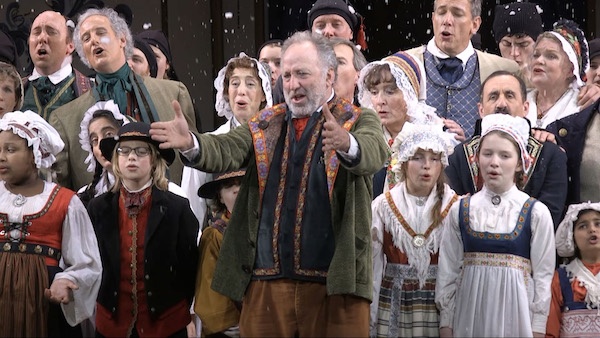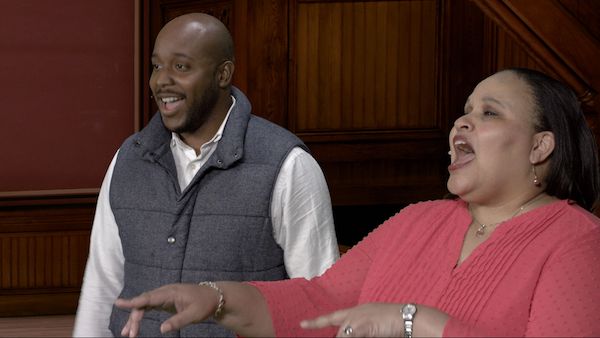Theater Review: The Christmas Revels 2020 — A Delightfully Virtual Revelation
By David Greenham
A 50th anniversary is a wonderful milestone, and I congratulate the Revels for looking back and huzzahing the occasion as they have.
The Christmas Revels 2020: A 50th Anniversary Virtual Celebration. Written and directed by Patrick Swanson. Music Direction by George Emlen. Costume Design by Heidi A. Hermiller. Make Up/Wigs by Seth Bodie. Set by Andy Barnett. Sound by Kem Stewart and Michael Kolowich, Video Producer. Virtual Chorus Effects by Sid Levin. Video Editing by Emma Stickgold. Production Management by Lynda Johnson. Virtual Studio by DigiNovations. Studio Production by Chuck Scott. Videography by Shawn Whitaker, Michael Kolowich, Nicole Albee, Christopher Mackos, and Bill Aydelott. Produced by Revels, inc. Available virtually through December 31, 2020.

Chorus Finale: David Coffin leads the audience and cast in The Sussex Mummers’ Carol, the production’s final song. Photo: courtesy of the Revels.
After 49 consecutive years of Christmas Revels at the beautiful Sanders Theater in Cambridge, Covid19 prevented what would probably have been a memorable celebration of half a century of tradition for many in the Boston area as well as those around the eight other locations that host Revels franchise affiliates across the country, stagings that have developed since the origination of the experiment in 1971.
Robbed of the opportunity for throngs of performers and fans to safely fill Sanders Hall this year, the creators cleverly decided to bring in living representations of “two stalwart audience members who have been present since the first Christmas Revels in 1971: the marble statues of James Otis, Jr. and Josiah Quincy.” Otis and Quincy (campily played by Boston stage stalwarts Paula Plum and Richard Snee) are joined virtually by song leader David Coffin, who will be recognizable to anyone who has seen the Revels over the last few decades — he’s been performing in the Revels for 40 years. In addition, we meet the artistic brain trust of the Revels: artistic director Patrick Swanson and music director George Emlen. They’re joined by Revels education director Johnny Nichols Jr. and guest performer Carolyn Saxon.
Since the setting is an empty theater — complete with a ghost light — it seems inevitable that the 2020 Revels would take the form of a nostalgic celebration of shadows of the past. That means the proceedings are made up of video footage of Revels gone by, a skillful gathering of curated clips.
The first half of the show focuses on the production’s early years and features a well-produced video, narrated by Noni Lewis, that provides context for founder Jack Langstaff’s dream. And then the journey with the Revels’ ghosts of Christmases past begins. Although the quality of the video interludes varies greatly, Revels regulars will love a lot of what they see. Newbies will get a sense of what the venerable tradition is all about.
A charming black-and-white clip from 1977 of Martin (Shag) Graetz doing a broom dance illustrates the simplicity of the concept. Each Revels is a themed vaudeville — a music hall performance of sorts — with choruses made up of adults and children, a band, and special guests serving as leading performers.
The 1983 Revels took a Slavic theme, so the Balkan music ensemble Evo Nas served as the special guest. A clip presents a rousing Bulgarian tune called “Krivo Horo.” A decade later, when the location was the Northlands, the Finnish/Russian Karelian Folk Music Ensemble demonstrated how music making can be a friendly competition via a traditional dance tune, “Kukku.”

Johnny Nichols Jr. and Carolyn Saxon perform the spiritual “Hold On” in a segment linked to Maya Angelou’s poem “Still I Rise,” which explores the ongoing journey toward justice and equality. Photo: courtesy of the Revels.
The large choruses tend to be creatively draped around the crowded stage for much of the Revels performance, so there are often moments where the visuals overtake the vocals. The 1995 Revels explored the notion of “King and Fool” and included beautiful bird puppets, made up of flowing fabrics, held up on long sticks. Likewise, in 2009, when the theme was America, a moving story about the Underground Railroad was chosen. Shadow puppets made their appearances behind a large screen upstage.
In 2016 Acadian and Cajun history was the focus – a production I reviewed for the Arts Fuse. The sorrowful song “Le Départ du Canada” was accompanied by projections of flames burning in the background as Acadians were force marched from their villages. The image was deeply moving and beautiful.
Sometimes the sets themselves became the highlight of the show, such as the 2012 Revels. The theme revolved around Irish immigration and performers were placed on the bow of a ship sailing to America. Deep dives into a culture through its music is also a specialty, such as the 1992 Celtic-themed trio of clips that include a traditional Scottish Highland dance, the famous working song “He Mandu,” and the spinning song “Tha Mi’n Duil.”
But it’s just as much fun to see the times where cultural styles are fused. The 1997 Roma show made cross-cultural connections twice. A Romanian dance called the “Câluş” is similar to Morris dancing, a Revels staple. So why not merge them? In addition, a Hindu dance dedicated to Shiva is the Eastern version of “The Lord of the Dance,” which ends the first act of each Revels performance. As the performers dance to Shiva, stalwart song leader Coffin emerges to sing “The Lord of the Dance,” inviting the cast and audience members to take a serpentine stroll into the lobby.

Yo-Yo Ma with audience: Cellist Yo-Yo Ma performs the peace round Dona Nobis Pacem with members of the Revels virtual audience. Photo: courtesy of Revels.
The 2020 Revels isn’t all about the past, however. In addition to the narrators, who were filmed in front of a green screen, this installment recruited a large crowd of friends and former chorus performers to rehearse and sing several numbers. These individual efforts were edited together. While this kind of mix-and-match is neither perfect nor ideal, the virtual chorus was a stirring homage to the resiliency of the Revels. What’s more, it’s a wonderful opportunity to see the joy on the faces of individual singers. In Sanders Theater the faces in the chorus easily become lost in the showbiz festivities — but here they’re all visible and marvelously expressive. The high point came with the traditional performance of “Dona Nobis Pacem.” Cellist Yo Yo Ma performs while the virtual audience and chorus sing — along with the 1991 audience and chorus. It’s a delight.
A 50th anniversary is a wonderful milestone, and I congratulate the Revels for looking back and huzzahing the occasion as they have. It’s inevitable that some cracks will show as we look back to the world we thought we knew. The Revels have made a few discoveries about race but, aside from wonderful performances from a soulful Janice Allen and a group of gentlemen known as the Silver Leaf Gospel Singers, most of the video clips tell a white history. Here’s hoping that the next 50 years finds artistic leadership, leading performers, choruses, and audience members who more accurately reflect the diversity of Cambridge, the Boston area, and New England. BIPOC, LGBTQ and differently abled individuals are critical parts of our community and history. Hopefully, future Revels will include these voices — which will only add even more volume to the holiday celebration.
David Greenham is an adjunct professor of Drama at the University of Maine at Augusta, and is the Associate Director for the Holocaust and Human Rights Center of Maine. He is the current chair of the Maine Arts Commission, and has been a theater artist and arts administrator in Maine for more than 25 years.
